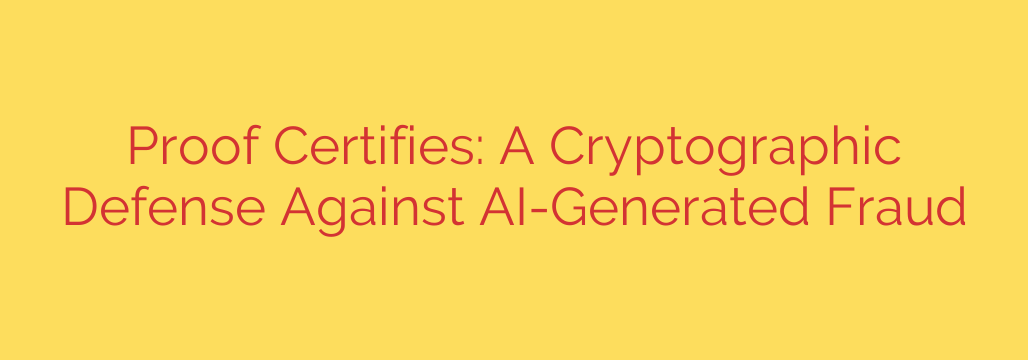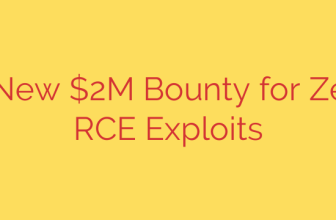
Beyond Detection: Verifying Reality in the Age of AI Deepfakes
We are living in an era of unprecedented technological advancement, but with it comes a growing and insidious threat: AI-generated fraud. Highly convincing deepfake videos, fabricated audio clips, and forged documents are no longer the stuff of science fiction. They are real-world tools used for scams, disinformation campaigns, and sophisticated cyberattacks, eroding the very foundation of digital trust.
For years, the primary defense has been detection—building AI models to catch other AIs. This has devolved into a digital cat-and-mouse game. As soon as a new detection method is developed, a more advanced AI generator emerges to bypass it. This reactive approach is a losing battle. The future of digital security requires a fundamental shift in strategy: from trying to spot the fake to cryptographically proving what is real.
The Problem with Simply Detecting Fakes
Relying on detection alone is fundamentally flawed. AI-generated content is becoming so sophisticated that it can be indistinguishable from reality, even to a trained eye. An AI detector might flag a real photo as fake (a false positive) or miss a skillfully crafted deepfake (a false negative). This uncertainty is precisely what bad actors exploit. When we can no longer be sure of what we see and hear, trust collapses.
The core issue is that detection algorithms are always playing catch-up. They are trained on yesterday’s fakes, leaving us vulnerable to tomorrow’s technology. A more robust solution is needed—one that is proactive, not reactive.
A New Paradigm: Cryptographic Proof of Origin
Imagine if every photo, video, or audio file was created with an unbreakable, built-in certificate of authenticity. This is the principle behind a new wave of security technology that uses cryptography to certify content at the moment of its creation.
Instead of analyzing pixels to search for tell-tale signs of manipulation, this method embeds a unique and verifiable digital signature directly into the content’s metadata. This process acts as a digital tamper-proof seal, providing a clear and reliable answer to the most important question: “Is this content original and unaltered?”
How Cryptographic Certification Works
This forward-thinking approach provides an elegant and powerful defense against manipulation. The process is based on established cryptographic principles and works in a few simple steps:
- Capture and Seal: When a device—like a smartphone camera or a microphone—captures content, it immediately generates a cryptographic proof. This proof is a unique digital fingerprint (often called a hash) of the original, raw data.
- Secure Association: This digital fingerprint is securely linked to the content it represents. It serves as a permanent record of the file’s state at the exact moment of its creation.
- Effortless Verification: Anyone who receives the file can easily verify its authenticity. By running a simple check, they can compare the file’s current state to its original cryptographic fingerprint.
- Irrefutable Results: If even a single pixel in an image is altered or a fraction of a second of audio is edited, the new digital fingerprint will not match the original. The verification will instantly fail, providing clear and irrefutable proof of tampering.
This method completely sidesteps the need to “detect” a fake. It doesn’t matter how convincing a manipulation is. If the cryptographic seal is broken, the content cannot be trusted as original. It shifts the burden of proof from the viewer to the creator.
Real-World Applications and the Future of Trust
The implications of this technology are vast and could help restore integrity across numerous industries.
- Journalism and Media: News organizations can prove their footage from the field is authentic, combating the spread of misinformation and “fake news.”
- Legal and Law Enforcement: The integrity of digital evidence, such as bodycam footage or security recordings, can be mathematically guaranteed, making it far more reliable in court.
- Financial Services: Banks and insurance companies can verify the authenticity of submitted documents, like IDs and contracts, drastically reducing identity theft and financial fraud.
- Personal Communication: Imagine a video call where you have cryptographic assurance that you are speaking to a real person, not a deepfake impersonator.
Actionable Security: What This Means For You
While this technology is still emerging, its principles offer a roadmap for navigating our complex digital world.
- For Individuals: Cultivate a healthy skepticism of unverified digital content, especially if it seems designed to provoke a strong emotional reaction. As this technology becomes more widespread, look for “certified” or “verified” icons on images and videos, similar to the blue checkmark on social media today.
- For Businesses: Begin exploring security solutions that focus on content authentication, not just threat detection. Protecting your brand from deepfake impersonations and ensuring the integrity of your digital communications will soon be a business necessity.
Ultimately, the fight against AI-generated fraud will not be won by building a better fake detector. It will be won by creating a system where authenticity is the default, and the truth is mathematically verifiable. By embedding proof at the source, we can begin to rebuild the digital trust that modern society depends on.
Source: https://www.helpnetsecurity.com/2025/10/10/proof-certify-authorized-digital-signing/








